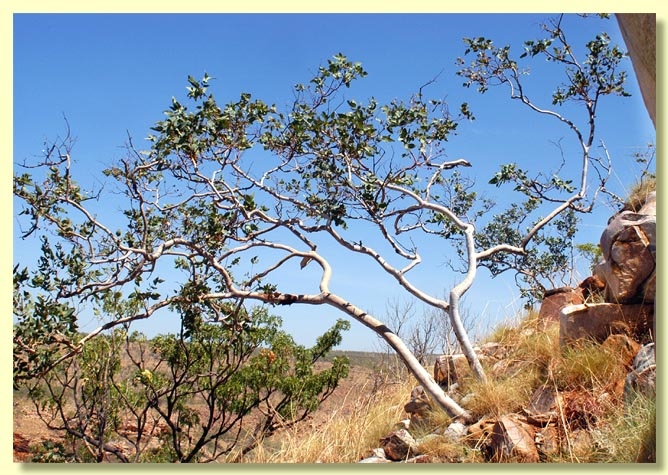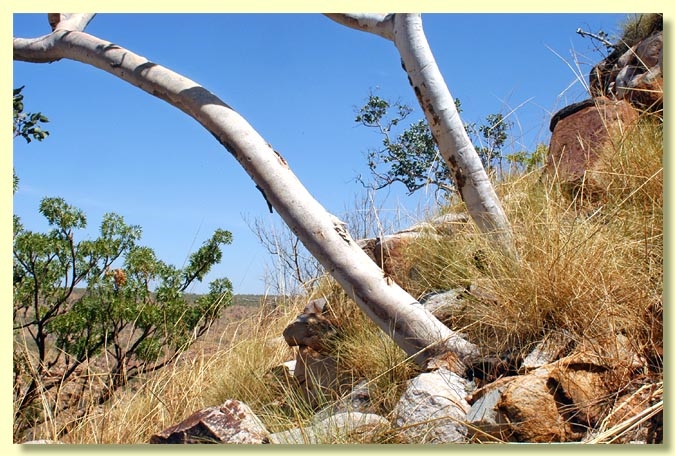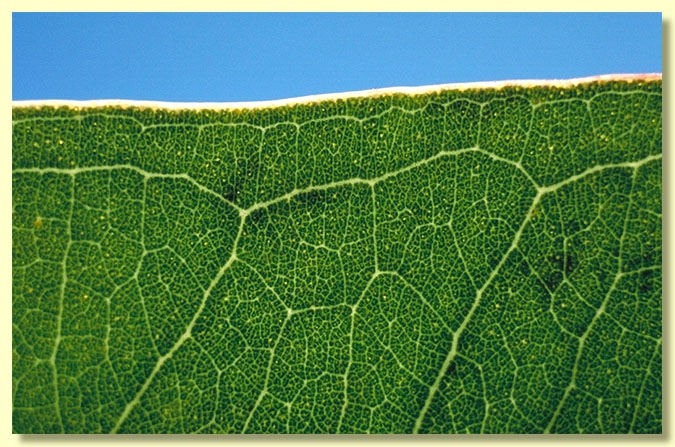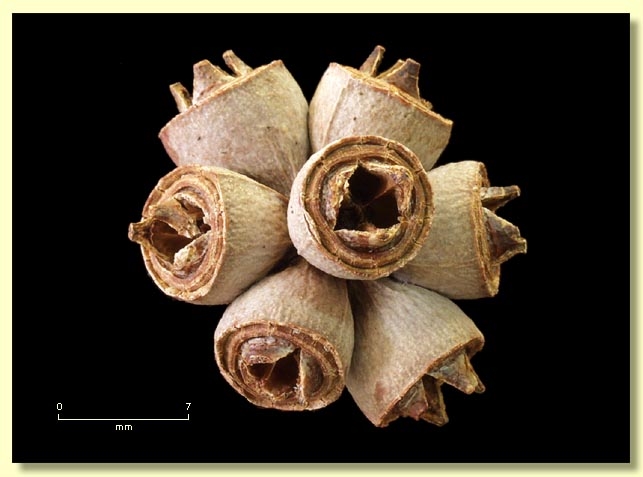Euclid - Online edition
Eucalyptus mooreana
Eucalyptus | Symphyomyrtus | Exsertaria | Subexsertae | Pyramidales
Eucalyptus mooreana W.Fitzg. ex Maiden, J. & Proc. Roy. Soc. New South Wales 47: 221 (1914).
T: summit of Mt Rason, Western Australia, Sept. 1905, W.V.Fitzgerald 1472; lecto: NSW, fide J.H.Maiden, Crit Revis. Eucalyptus 5: 101 (1920); isolecto: BM, K, PERTH.
Small tree or mallee to c. 6 m tall, often of poor form. Forming a lignotuber.
Bark smooth and powdery throughout, new bark pale pink, maturing to white or grey. Branchlets glaucous.
Juvenile growth (coppice or field seedlings to 50 cm) : not seen but since crown has sessile opposite leaves, presumed juvenile, then coppice growth will probably be similar.
Crown leaves juvenile, opposite, sessile; blade variable in shape within a single crown, orbicular to elliptical to cordate, less commonly lanceolate, (3)6–13 cm long, 3–8 cm wide, base amplexicaul, margin entire, apex rounded to pointed or emarginate, concolorous, dull, green to grey-green to glaucous, side-veins at a wider angle than 45° to the midrib, reticulation very dense, intramarginal vein present, often doubled with two parallel looping veins well removed from the margin, oil glands small, island or intersectional.
Inflorescence axillary unbranched, peduncles 0.7–1.8 cm long, buds per umbel 7, sessile or rarely on pedicels to 0.2 cm long. Mature buds ovoid to diamond-shaped, 1–1.2 cm long, 0.5–0.7 cm wide, glaucous over red, scar present (or sometimes absent on younger buds as outer operculum is shed late in bud development), operculum conical (0.5–0.8 cm long), hypanthium sometimes 2-ridged, stamens irregularly flexed or with some outer stamens erect and the inner ones inflexed, anthers oblong, versatile, dorsifixed, dehiscing by longitudinal slits, style long and straight, stigma blunt, locules 3 or 4(5), the placentae each with 6 vertical rows of ovules. Flowers white.
Fruit sessile to rarely very shortly pedicellate (pedicels 0–0.1 cm long), cup-shaped to hemispherical, 0.6–0.8 cm long, 0.6–0.8(0.9) cm wide, usually glaucous, but glaucescence weathering with age, disc raised or level, convex to annular, valves 3 or 4(5), exserted.
Seeds dark brown to black, 1–2 mm long, ± obliquely pyramidal, dorsal surface shallowly to sometimes deeply reticulate, sides ribbed, edge of seed sharply toothed, hilum terminal.
Cultivated seedlings (measured at ca node 10): cotyledons oblong-reniform; stems round to square in cross-section; leaves sessile, opposite for at least 14 nodes, deltoid to cordate or ovate, 4–9.3 cm long, 2–5.3 cm wide, base amplexicaul to truncate or broadly tapering, apex bruntly pointed, dull, mid-green, discolorous.
Flowering time unknown.
A stunted tree or mallee restricted to the summits and steep slopes of peaks in the King Leopold Range and Lady Forrest Range, in the Kimberley region, Western Australia, occurring on sandstone, quartzite and granite. Characterised by the straggly habit, the smooth white powdery bark, the relatively large, sessile, opposite, green-grey to glaucous, cordate leaves of the mature crown, the seven-budded umbels and the sessile buds and fruit.
Eucalyptus mooreana belongs to a small group of species closely related to the red gums. This group is distinguished by having smooth powdery bark, adult leaves with dense to very dense reticulation and intersectional or absent oil glands, buds with incurved or erect stamens, fruit with an annular disc and more or less obliquely pyramidal, toothed seeds with a terminal hilum. Other members of this group are E. pantoleuca, E. herbertiana, E. cupularis, E. glomericassis and E. gregoriensis.
Within this group E. mooreana could only be confused with E. pantoleuca. Both have relatively large, opposite, blue-grey to glaucous leaves in the mature crown. They are easily separated as E. pantoleuca has distinctly petiolate leaves in the mature crown, while E. mooreana is sessile; E. pantoleuca is three-budded in each umbel, while E. mooreana is seven-budded; and E. pantoleuca has much larger fruit, usually wider than 1.5 cm, while E. mooreana is 0.9 cm or slightly narrower. The other members of this group, i.e. E. cupularis, E. gregoriensis, E. herbertiana and E. glomericassis, all have lanceolate adult leaves.
Because of its habitat and large, opposite, often glaucous, sessile leaves, E. mooreana should not be confused with other related white gums growing within its area of occurrence, i.e. E. alba var. australasica, E. apodophylla, E. bigalerita, E. brevifolia, E. camaldulensis, E. confluens, E. herbertiana, E. houseana, E. ordiana and E. rupestris.
E. apodophylla does have relatively large sessile, glaucous to grey-green leaves in the mature crown but can be distinguished by having globular to obovoid buds with a round operculum, while E. mooreana has broadly fusiform buds with an acute operculum. Eucalyptus houseana is a much larger tree than E. mooreana and occupies a seasonally moist low-lying habitat. All the other members of this group have distinctly petiolate leaves in the mature crown.
Eucalyptus mooreana is listed as "Vulnerable" under the Australian Government Environment Protection and Biodiversity Conservation Act 1999 (EPBC Act). Further information may be found at this web address:
http://www.environment.gov.au/cgi-bin/sprat/public/sprat.pl
MORE ABOUT RED GUMS AND OTHER ASSOCIATED GROUPS
Eucalyptus mooreana: named in honour of Sir Newton James Moore (1870–1936). Newton Moore was born in Fremantle, Western Australia and in his teenage years days started work on the survey of the Great Southern Railway in Western Australia. He had a keen interest in politics and was a member of the Bunbury Town Council and later mayor. In 1904 he was elected to the Legislative Assembly as the member for Bunbury, eventually becoming the Minister for Lands and Agriculture in 1905 and finally Premier of Western Australia in 1906.
















